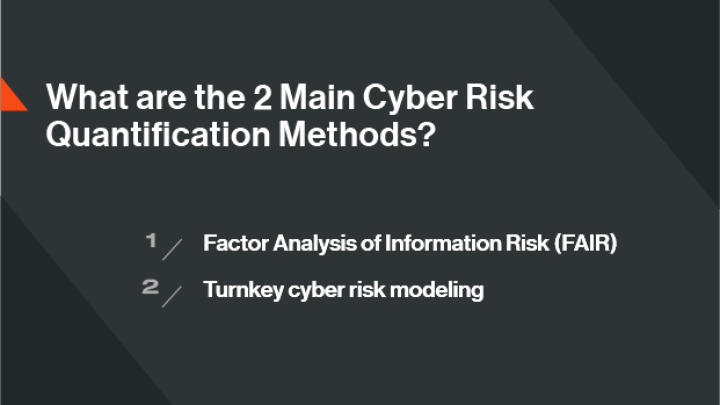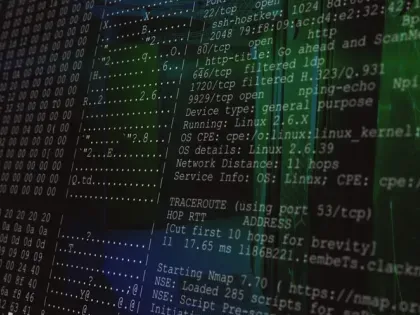Cyber Risk Quantification Methods
Tags:

Cyber risk quantification is the task of identifying the financial and business impact of cyber risk.
By quantifying risk in business terms, cyber leaders provide their business leaders and board members with the context and data-driven metrics to build a greater understanding of the impact of cyber risk and understand what steps can be taken to mitigate it.
A rise in cyber incidents and an increase in cyber risk governance and regulations is fueling the need for you to perform and integrate cyber risk quantification methods into your cybersecurity program.
Cyber risk quantification (CRQ) empowers you with data-driven metrics that indicate your exposure to cyber risk. But instead of presenting these findings in technical terms – such as traditional red-amber-green heat maps and scorecards – CRQ helps you talk about risk in terms of business and financial impact.
For instance, with CRQ you can answer important questions such as:
- “How much could we lose financially if we don’t address a particular gap in our security program?”
- “What kind of cyber events would have the most business impact?”
- “Which security projects are priorities and critical to stabilizing risk?”
- “What investments do we need to make in security controls/resources – and where?”
Before you get started with CRQ, you need to define a strategy for measuring and quantifying risk.
How to select the right cyber risk quantification method
There are two leading cyber risk quantification methods or frameworks. Let's take a look at both and see which might work best for your business.
1. Factor Analysis of Information Risk (FAIR)
FAIR is a model for understanding, analyzing, and quantifying cyber risk in any organization.
According to the FAIR Institute:
- FAIR can help you understand, analyze, and quantify cyber risk and operational risk in financial terms.
- It is unlike risk assessment frameworks that focus their output on qualitative color charts or numerical weighted scales.
- It builds a foundation for developing a robust approach to information risk management.
FAIR is an in-depth model that includes its own risk taxonomy and technical standards. Its probability-based approach can be applied to any type of asset your business works with.
Although FAIR is widely adopted, it’s a highly manual and time-consuming approach to CRQ.
A FAIR assessment requires you to gather infinite detail about your digital environment (systems, assets, data flow) and your vendors and suppliers (especially those who have direct access to your systems or data).
Then, you must identify potential threats, evaluate your controls, categorize risks (high, medium, low), and calculate potential impacts across a variety of scenarios.
Because of the effort required to collect this data and the expertise needed to model various cyber risks to calculate a risk exposure range, FAIR assessments are complex, hard to scale, and not easily repeatable.
2. Turnkey cyber risk modeling
Automated, turnkey cyber risk modeling is an alternative method to FAIR. A good example of such a model is Bitsight Financial Quantification for Enterprise Cyber Risk.
Using Bitsight for CRQ, you can streamline the process of quantifying your cyber risk financially – without investing in any additional headcount or resources.
The solution combines data about your digital assets and the systems they rely on, business information, cyber insurance claims, and cyber scenario probability calculations.
You can quickly and easily simulate your organization’s financial exposure across multiple types of business impact scenarios (ransomware, data breach, denial of service attack, third-party breach, regulatory compliance issues, etc.).
Available on-demand, Bitsight calculates cyber risk in a repeatable and efficient manner without the need to hire any additional personnel or engage a consulting firm.
Findings are presented in a graphical interface that lets you drill down into cyber event examples so you can diagnose the underlying causes of financial exposure quickly and more efficiently.
In this way, Bitsight helps you:
- Streamline your process for quantifying cyber risk
- Make more informed business decisions using real-time data
- Report effectively to the board
- Using these insights, your team can determine which risks to accept, mitigate, or transfer - and where to focus limited time, budget, and resources.
Why quantify cyber risk at all?
Cyber risk quantification is the process of analyzing and assigning data-driven metrics to cyber risks that have been previously identified.
The ultimate objective of cyber risk quantification is to present risk data in business terms, providing critical context for business leaders and board members as they make decisions about cybersecurity matters and financial priorities.
It transforms the intangible nature of risk into tangible business impacts, giving business leaders a better handle on various risk factors so they can make smarter decisions and prioritize remediation efforts.
Cyber risk quantification may be based on KPIs, security ratings, or modeling techniques that are common to cyber insurers as they gauge potential financial exposure.
The right strategy for cyber risk quantification enables organizations to:
- Track tangible and intangible implications of risk from a financial standpoint.
- Clearly identify the organization’s probable cyber exposure and its impact.
- Promote informed discussions around accepting, mitigating, or transferring risk through insurance.
- Increase cybersecurity awareness beyond the IT team to the rest of the organization.
- Make smarter investments that reduce overall cyber exposure.
Four benefits of cyber risk quantification with Bitsight
Easily quantify cyber risk with existing resources
Manage cyber risk quantification without additional headcount or resources. Bitsight’s quantified view of cyber risk complements Bitsight Security Ratings to simulate the financial impact of risk across multiple cyber scenarios.
Rely on proven models
The underlying model that drives Bitsight’s Financial Quantification is based on models to serve the world’s largest insurance and reinsurance carriers. By leveraging multiple cyber risk models, this approach enables cyber risk managers to efficiently price risk and manage billions of dollars of cyber exposure with a high degree of confidence.
Quantify risk on-demand
In contrast to traditional consulting engagements or internal projects, Bitsight’s Financial Quantification is available on demand and is easily repeatable. With the ability to drill down into cyber event examples, quickly and efficiently diagnose the underlying causes that may impact financial exposure.
Transform cyber risk discussions
By financially quantifying cyber risk, business leaders and board members intuitively understand risk in financial terms and evaluate the effectiveness of cybersecurity programs.


